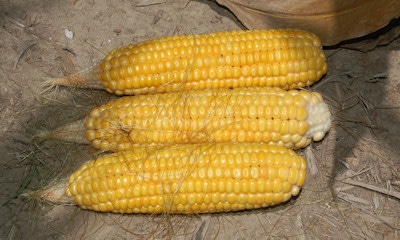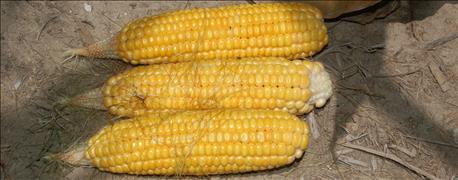April 18, 2016

Several years ago one university researcher worked with a girthy- eared and a long- eared corn hybrid that he obtained from a seed company. He called the girthy-eared hybrid “fixed-eared” and the long eared hybrid “flex-eared.” He also coined ‘work horse’ and ‘race horse’ to differentiate the hybrids for their adaptability to the environment.
The terms were interesting in defining certain types of hybrids, but were limited in scope. Somehow the seed industry marketers picked up these terms and used them as selling gimmicks. Let’s look at how corn plants really respond to changing environmental conditions. Are they really either fixed or flex eared?

FIXED OR FLEX? These ears may appear to be ‘fixed ears,’ but Dave Nanda says they can flex by adding rows of kernels.
The ultimate goal of every species is to create as big a progeny as possible under any given environmental situation. Most plants are constantly adjusting to their macro and micro environment to maximize the number of viable progeny or seeds possible.
If we understand this concept, we will know how to make our crops comfortable and ‘happy’ so they can produce maximum yield. Plants are like our employees working in a factory. If they’re too cold or too hot or hungry or thirsty for any element, they’re not going to be fully productive.
Growers who produce contest- winning yields understand this concept. They make sure their crop plants don’t see too many unhappy days.
When we plant our corn crops, we do everything we can to prepare a good seedbed; plant the seed at the right depth of 2-3 inches so the seed will have moisture for germination; and plant at the right speed of 4 to 6 miles per hour, so the skips and doubles are minimized. We try to apply sufficient nutrients, especially nitrogen, with starter if needed, and side-dressing when possible.
We try to control weeds early because we know early weeds can hurt yield. Corn plants sense their presence early on by reflectance of infra-red light from other green plants. We can’t wait for weeds to get tall and control them with one application of glyphosate, Liberty or other herbicides. Corn plants start to plan early on how to respond to the environment and maximize the number of viable seeds they can produce.
Plants at knee high stage are already deciding whether to produce one or more ears. Plants that emerge even two to three days late will likely produce a little ear or no ear and act like weeds. Doubles will produce nubbins. Plants with large spaces because of skips may produce one large ear or add a second ear.
At waist high so-called “fixed ear” hybrids may flex their muscle by adding two to four additional rows.
I prefer to call them “girthy-eared” hybrids because they can also flex in a different way and at a different stage of life. They’re not really ‘fixed ears’ after all.
- Nanda is President of Agronomic Crops Consultants. He may be reached at [email protected] or call him at 317-910-9876.
You May Also Like




